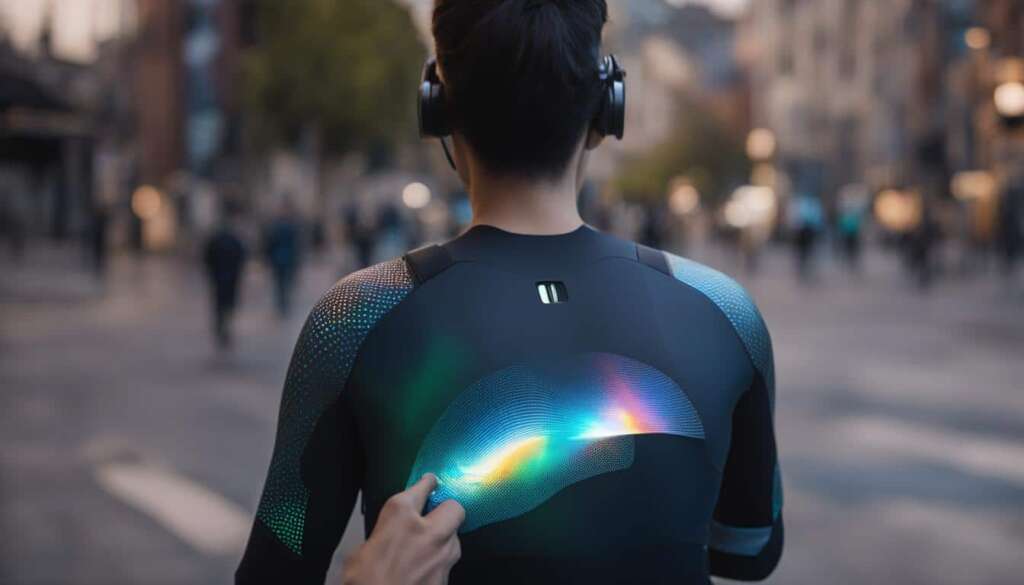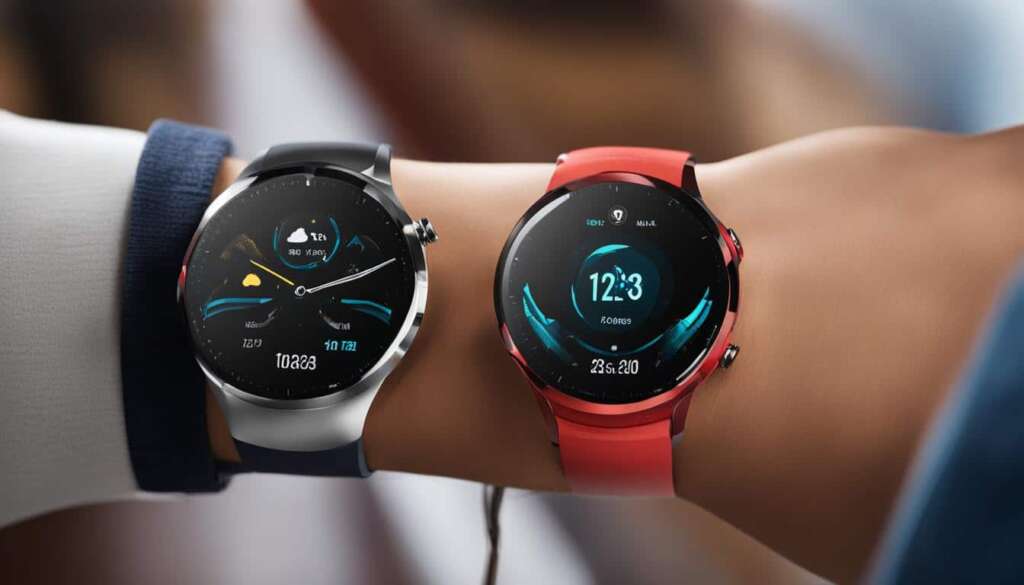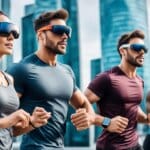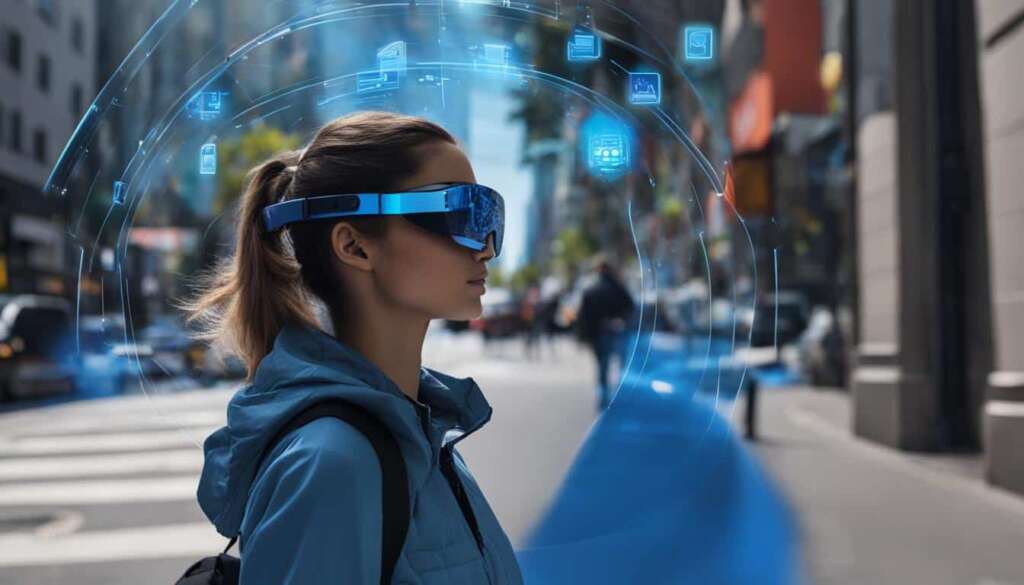Table of Contents
Wearable technology is revolutionising how we interact with the digital world and integrating it into our daily lives. These devices, such as smartwatches and fitness trackers, are changing the way we communicate, track our health, and perceive reality. The wearable computing market is expected to reach a value of USD 231 Billion by 2032, growing at a CAGR of 14.60% during the forecast period from 2023 to 2032.
The growing demand for wearable technology continues to increase as consumers search for more efficient and integrated ways to stay connected and monitor their health. Wearables like fitness trackers and smartwatches have gained immense popularity due to their ability to provide quick access to messages, notifications, and health data.
Wearable devices have become essential for individuals concerned about their health and fitness. These devices can measure heart rate, track sleep patterns, count steps, and provide immediate feedback during exercise. The focus on health and fitness has been a major driver of the wearable technology market.
Wearable technology is constantly evolving due to technological advancements. Sensors, biometrics, and other miniaturised parts are continuously improving, allowing for better data collection and multiple functions, all with sleek and compact designs. These advancements have contributed to the growth of the wearable technology market.
The convergence of fashion and technology has blurred the line between functional and aesthetic wearables. The latest trends in clothing and accessories are becoming more fashionable, comfortable, and appealing to a wider audience. Wearable technology is no longer just about functionality but also about style.
The integration of augmented reality (AR) and virtual reality (VR) into wearable technology opens up new possibilities in gaming, entertainment, education, and training. VR glasses and headsets are creating immersive experiences, allowing users to interact with virtual objects overlaid onto the real world.
The growth of wearable computing presents both opportunities and challenges. Ensuring energy efficiency and longer battery life is a major challenge for wearable devices. Data security and privacy concerns arise due to the collection of personal health information. Interoperability between different platforms and devices is an ongoing challenge. Regulatory requirements need to be met, especially for health-focused wearables.
The wearable tech industry is evolving and bringing revolutionary advancements to our daily lives. Key trends include the focus on health and wellness, the emergence of smart clothing, the integration of augmented reality, the redefinition of personal assistants, and the move towards sustainable and eco-friendly designs. These trends shape the future of wearable technology and its impact on our lives.
The market for wearable technologies continues to expand, offering new possibilities for connectivity, convenience, and better health. As technology advances and consumer expectations change, wearable technology will continue to influence our future. The path of wearable computing involves continuous exploration and development, leading us towards a more connected and empowered society.
The Growing Demand for Wearable Technology
The demand for wearable technology continues to rise as consumers search for more efficient and integrated ways to stay connected and monitor their health. Wearables such as fitness trackers and smartwatches have gained immense popularity due to their ability to provide rapid access to messages, notifications, and health data. These devices offer a convenient solution for individuals who are constantly on the go and need instant access to important information.
One of the key drivers behind the growing demand for wearable tech is the desire for quick and effortless connectivity. Smartwatches, in particular, have become an essential accessory for many, allowing users to receive notifications and stay connected to their smartphones without having to constantly check their devices. This convenience factor has made smartwatches a must-have gadget for those looking to streamline their busy lifestyles.
In addition to rapid access, the health monitoring capabilities of fitness trackers and smartwatches have also contributed to the surge in demand. These devices can track various health metrics such as heart rate, steps taken, and sleep patterns, providing users with valuable insights into their overall well-being. With an increasing focus on health and wellness, wearable technology has become an indispensable tool for individuals looking to improve their fitness levels and monitor their progress.
“Wearable technology offers a seamless integration of technological and health-related functionalities, making it an attractive choice for individuals seeking to enhance their daily lives.”
The growing demand for wearable tech is a testament to the seamless integration of technological and health-related functionalities offered by these devices. With their ability to provide rapid access to notifications and health data, fitness trackers and smartwatches have become essential companions for individuals seeking to enhance their daily lives.
| Benefits of Wearable Technology | Examples |
|---|---|
| Convenient access to messages and notifications | Smartwatches |
| Health monitoring and fitness tracking | Fitness trackers |
| Integration with personal devices | Smartwatches, fitness trackers |
| Sleek and stylish designs | Smartwatches |
In conclusion, the growing demand for wearable technology can be attributed to the desire for rapid access to information and the increasing focus on health and wellness. Fitness trackers and smartwatches offer convenience, connectivity, and valuable health insights, making them an essential part of today’s tech-savvy lifestyle.
The Focus on Health and Fitness
Wearable devices have become essential for individuals concerned about their health and fitness. These devices offer a range of features and capabilities that allow users to track and monitor various aspects of their well-being. From measuring heart rate to tracking sleep patterns and counting steps, wearable devices provide valuable insights into personal health and fitness levels.
The ability to monitor heart rate is one of the key advantages of wearable technology in the health and fitness space. Wearable devices equipped with heart rate sensors can provide real-time data on heart rate zones and fluctuations during exercise, allowing users to optimize their workouts and monitor their cardiovascular health. This feature is particularly beneficial for individuals with specific health concerns or those looking to improve their fitness levels.
In addition to heart rate monitoring, wearable devices can also track sleep patterns, providing users with valuable information about the quality and duration of their sleep. By analyzing sleep data, individuals can make informed decisions about their sleep habits and work towards improving the quality of their rest. This can have a significant impact on overall health and well-being, as sleep plays a crucial role in maintaining optimal physical and mental function.
| Benefits of Wearable Devices for Health and Fitness |
|---|
| Accurate heart rate monitoring |
| Insight into sleep patterns |
| Tracking of steps and activity levels |
| Personalized fitness recommendations |
Furthermore, wearable devices allow users to track their daily activity levels by counting steps and monitoring physical movement. This feature encourages individuals to stay active throughout the day and can help in achieving fitness goals. By providing data on step count and activity levels, wearable devices motivate users to increase their physical activity and lead a more active lifestyle.
Overall, the focus on health and fitness has been a driving force behind the growth of the wearable technology market. With the ability to monitor heart rate, track sleep patterns, and count steps, wearable devices empower individuals to take control of their health and make informed decisions about their fitness journeys.
Key Features of Wearable Devices for Health and Fitness:
- Heart rate monitoring
- Sleep pattern tracking
- Step counting and activity tracking
- Personalized fitness recommendations
Technological Advancements in Wearable Tech
The world of wearable technology is constantly advancing, thanks to ongoing technological advancements. These developments have revolutionized the capabilities and design of wearable devices, making them more sophisticated, versatile, and user-friendly.
One key area of progress is in sensors. Modern wearable devices are equipped with advanced sensors that can collect and analyze various types of data. These sensors enable accurate tracking of biometrics such as heart rate, blood pressure, and sleep patterns, providing users with valuable insights into their health and well-being.
In addition to improved sensor technology, wearable tech also benefits from advancements in data collection and analysis. With increased processing power and memory capacity, wearable devices can now collect, store, and interpret large amounts of data. This enables the creation of detailed and personalized health and fitness profiles, helping individuals make informed decisions about their lifestyle and habits.
Sleek designs have also played a significant role in the evolution of wearable technology. Early wearables were often bulky and cumbersome, but manufacturers have made great strides in making devices more compact, lightweight, and aesthetically appealing. The emphasis on sleek designs has made wearables more comfortable to wear and has broadened their appeal to a wider audience, blurring the line between fashion and technology.
| Technological Advancements in Wearable Tech | Benefits |
|---|---|
| Sensors | – Accurate biometric tracking – Real-time health monitoring – Personalized insights into well-being |
| Data Collection and Analysis | – Detailed health and fitness profiles – Informed decision-making – Customized recommendations |
| Sleek Designs | – Enhanced comfort – Aesthetically appealing – Increased adoption and acceptance |
With ongoing technological advancements, the future of wearable technology looks promising. We can expect further improvements in sensors, data collection, and sleek designs, leading to even more advanced and user-friendly wearable devices. These advancements will continue to shape the way we monitor our health, interact with technology, and integrate wearables into our daily lives.

The Future of Wearable Technology
The future of wearable technology holds exciting possibilities. As sensors become smaller and more powerful, we can anticipate even more accurate health tracking and monitoring. The integration of artificial intelligence (AI) and machine learning algorithms will enable wearables to provide personalized recommendations and predictions, taking health and fitness to new levels.
Another area of potential growth is in the field of biometrics. Wearable devices may soon be able to measure a wider range of biometric data, providing users with a comprehensive picture of their overall well-being. This could include metrics such as body temperature, hydration levels, and stress levels, allowing individuals to better understand and manage their health.
As wearable technology continues to advance, we can expect to see more innovative applications in various industries. From healthcare and sports to entertainment and education, wearables have the potential to transform how we live, work, and play. The integration of augmented reality (AR) and virtual reality (VR) technologies will bring immersive experiences to a whole new level, unlocking new possibilities for gaming, training, and communication.
The Convergence of Fashion and Technology
The world of fashion and technology has come together in a seamless fusion, blurring the line between functionality and aesthetics. Wearable technology is no longer just about being a cutting-edge gadget; it has become a fashion statement that combines style and innovation. With fashion and tech working hand in hand, wearables are becoming more fashionable, comfortable, and appealing to a wider audience.
Gone are the days when wearing a fitness tracker or smartwatch meant sacrificing style for functionality. Today, wearable technology has evolved to offer both form and function. Fashion-forward individuals can now choose from a wide range of wearable devices that seamlessly integrate into their outfits.
Wearable technology is no longer just about functionality, but also about style. It has become a way for individuals to express their personal fashion sense while enjoying the benefits of innovative technology. (Source: First source)
One of the key trends in wearable technology is the development of smart clothing. This innovative concept combines fashion with technology to create garments that can monitor vital signs, adjust temperature, or even change colors based on external factors. Imagine a dress that adapts to the weather or a jacket that tracks your heart rate during a workout. Smart clothing takes wearable technology to a whole new level, enhancing not only our style but also our overall well-being.
| Benefits of the Convergence of Fashion and Technology | Examples |
|---|---|
| Enhanced style and personal expression | Smartwatches that resemble traditional watches |
| Increased comfort and wearability | Flexible and breathable smart fabrics |
| Seamless integration into everyday life | Smart jewelry that doubles as fitness trackers |
| Greater accessibility and appeal | Wearable devices designed in collaboration with renowned fashion brands |
The convergence of fashion and technology has opened up a world of possibilities for wearable technology. As technology continues to advance, we can expect even more innovative and stylish wearables that cater to our individual preferences and needs.
Augmented Reality and Virtual Reality Integration
Augmented reality (AR) and virtual reality (VR) have revolutionized the world of wearable technology, offering immersive experiences in various industries such as gaming, entertainment, education, and training. AR blends virtual elements with the real world, while VR creates a completely virtual environment.
In the gaming industry, AR and VR have transformed the way we play and interact with games. AR gaming allows players to see virtual objects overlaid onto their real environment, bringing virtual content into the real world. On the other hand, VR gaming provides a fully immersive experience where players are transported into a virtual world, enhancing the level of engagement and realism.
The integration of AR and VR into wearable technology also extends beyond gaming. In the entertainment industry, AR headsets can provide virtual tours, allowing users to explore museums, historical landmarks, or even space. VR headsets offer immersive movie-watching experiences, transporting viewers into a virtual cinema or simulated environments that complement the content being watched.
AR and VR have also found their place in education and training. AR can be used to enhance learning by overlaying educational content onto real-world objects, making complex concepts more tangible and engaging. VR, on the other hand, enables immersive training simulations, allowing professionals to practice complex tasks in a safe and controlled environment.
With the continuous advancements in AR and VR technology, wearable devices equipped with these capabilities are becoming increasingly popular. The integration of AR and VR into wearable technology opens up new possibilities, creating more interactive experiences and expanding the potential applications of wearable devices beyond communication and health monitoring. As technology continues to evolve, we can expect even more innovative uses of AR and VR in the field of wearable computing.
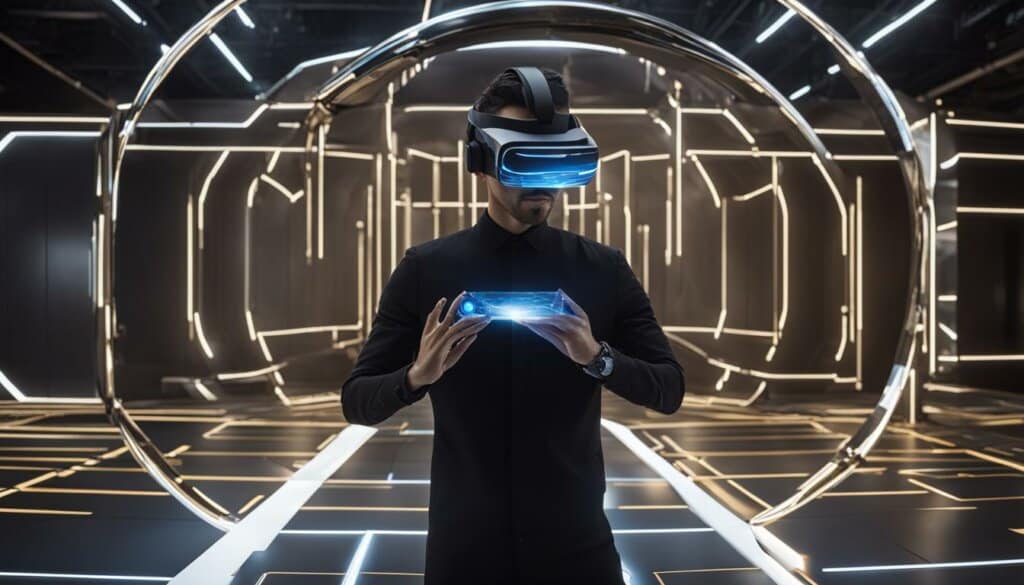
| Industries | Applications |
|---|---|
| Gaming | AR gaming, VR gaming |
| Entertainment | Virtual tours, immersive movie-watching |
| Education | AR-enhanced learning, immersive training simulations |
| Training | Professional skills practice in a safe environment |
Table: Applications of AR and VR integration in wearable technology.
Opportunities and Challenges in Wearable Computing
As wearable computing continues to gain momentum, it brings forth a plethora of opportunities and challenges for businesses and consumers alike. These advancements in technology offer the potential for improved efficiency, convenience, and personalized experiences. However, they also raise concerns about energy efficiency, data security, privacy, interoperability, and regulation.
Energy efficiency is a significant challenge in the wearable technology industry. As devices become more powerful and offer additional features, they consume more power, resulting in shorter battery life. This poses a hurdle as users demand wearable devices that can keep up with their daily activities without needing frequent charging. To overcome this challenge, manufacturers must invest in research and development to create more efficient battery technologies and optimize power consumption across various functionalities.
Data security and privacy are critical considerations in the adoption of wearable devices. As these devices collect and transmit personal health information, there is a need for robust security measures to protect user data from unauthorized access or breaches. Strong encryption protocols, secure data storage, and user consent mechanisms are essential to ensure the privacy and integrity of sensitive information.
Interoperability is another challenge in the wearable computing landscape. With multiple brands and platforms available, there is a need for seamless integration and compatibility between different devices and ecosystems. Users want the flexibility to sync their wearable devices with their smartphones, tablets, or other gadgets effortlessly. Standardization efforts and industry collaborations are crucial to overcome interoperability challenges and provide a unified user experience.
Regulatory frameworks play a vital role in shaping the wearable technology industry. Particularly in the healthcare sector, wearables that monitor vital signs or provide medical insights need to comply with stringent regulations to ensure accuracy, safety, and reliability. Regulatory bodies must establish clear guidelines and standards for wearable devices to safeguard consumer interests and maintain industry credibility.
| Opportunities | Challenges |
|---|---|
| Enhanced efficiency and convenience | Energy efficiency and battery life |
| Personalized experiences | Data security and privacy |
| Improved health monitoring | Interoperability |
| Seamless integration with other devices | Regulatory compliance |
In summary, the growth of wearable computing presents exciting opportunities for innovation and enhanced user experiences. However, challenges such as energy efficiency, data security, privacy, interoperability, and regulation must be addressed for widespread adoption and acceptance. As the industry continues to evolve, collaboration between stakeholders and ongoing technological advancements will pave the way for a future where wearable devices seamlessly integrate into our daily lives.
Trends in Wearable Technology
The wearable tech industry is constantly evolving, bringing revolutionary advancements to our daily lives. Let’s explore some of the key trends that are shaping the future of wearable technology and its impact on our lives.
Focus on Health and Wellness
One significant trend in wearable technology is the increasing focus on health and wellness. Wearables are no longer just about tracking steps or calories; they now monitor various biometrics and provide real-time insights into our overall well-being. From heart rate monitoring to sleep analysis, these devices help individuals take control of their health and make informed decisions to improve their overall wellness.
Emergence of Smart Clothing
Smart clothing is another trend that is transforming the wearable technology landscape. These innovative garments are embedded with sensors and microchips that can track vital signs, body movements, and even detect potential health issues. Smart clothing offers the convenience of wearable technology while seamlessly integrating into our everyday attire, making it a promising trend for the fashion-conscious individuals who value style and functionality.
Integration of Augmented Reality
The integration of augmented reality (AR) is revolutionizing the way we experience wearable technology. AR glasses and headsets are providing immersive experiences in various fields such as gaming, entertainment, education, and training. By overlaying virtual objects onto the real world, these devices create interactive and engaging experiences, opening up new realms of possibilities.
Redefinition of Personal Assistants
Personal assistants have taken a new form in wearable technology. Voice-activated smart assistants, like wearable smartwatches or earphones, can perform various tasks such as setting reminders, answering queries, and even controlling other smart devices in our homes. With the ability to provide instant assistance and streamline our daily activities, these personal assistants are becoming an integral part of our lives.
Moving Towards Sustainable Designs
The wearables industry is also embracing sustainability. Companies are focusing on developing eco-friendly wearable devices by incorporating sustainable materials and reducing energy consumption. By prioritizing sustainability, the industry aims to minimize its environmental impact and create products that align with the growing demand for sustainable and responsible technologies.
| Trends in Wearable Technology | Description |
|---|---|
| Focus on Health and Wellness | Wearable devices are increasingly focused on monitoring health and wellness, providing real-time insights and empowering individuals to make informed decisions. |
| Emergence of Smart Clothing | Smart clothing integrates wearable technology seamlessly into our everyday attire, offering style, comfort, and functionality. |
| Integration of Augmented Reality | Augmented reality enhances the wearable experience, creating immersive and interactive environments in various fields. |
| Redefinition of Personal Assistants | Voice-activated personal assistants in wearables provide instant assistance and streamline daily activities. |
| Moving Towards Sustainable Designs | The wearables industry is prioritizing sustainability by using eco-friendly materials and reducing energy consumption. |
Conclusion
The market for wearable technologies continues to expand, offering new possibilities for connectivity, convenience, and better health. Wearable technologies have revolutionized how we interact with the digital world, integrating it seamlessly into our daily lives. These devices, such as smartwatches and fitness trackers, have become indispensable in providing quick access to notifications, messages, and health data.
As technology advances and consumer expectations evolve, wearable technology will continue to shape our future. The convergence of fashion and technology has blurred the line between functionality and style, making wearables not only useful but also fashionable and comfortable. The integration of augmented reality (AR) and virtual reality (VR) into wearables opens up exciting opportunities in gaming, entertainment, education, and training.
However, along with these opportunities come challenges. Ensuring energy efficiency and longer battery life remains a top priority for wearable devices. Data security and privacy concerns arise due to the collection of personal health information. Interoperability between different platforms and devices remains an ongoing challenge. Regulatory requirements, especially in the health-focused wearables sector, need to be met.
Despite these challenges, the path of wearable computing involves continuous exploration and development, leading us towards a more connected and empowered society. Wearable technologies not only enhance our daily lives but also have the potential to improve our health and well-being. With wearable tech, we can stay connected, enjoy convenience, and strive for better health in an increasingly digital world.
FAQ
What is wearable technology?
Wearable technology refers to devices that can be worn on the body, such as smartwatches and fitness trackers, that integrate technology into our daily lives.
How is the wearable technology market expected to grow?
The wearable computing market is projected to reach a value of USD 231 Billion by 2032, with a compound annual growth rate of 14.60% during the forecast period from 2023 to 2032.
What are the popular wearable devices?
Fitness trackers and smartwatches have gained immense popularity due to their ability to provide quick access to messages, notifications, and health data.
How do wearable devices benefit health and fitness?
Wearable devices can measure heart rate, track sleep patterns, count steps, and provide immediate feedback during exercise, making them essential for individuals concerned about their health and fitness.
What advancements have contributed to the growth of wearable technology?
Wearable technology is constantly evolving due to improvements in sensors, biometrics, and miniaturized parts, allowing for better data collection and multiple functions, all with sleek and compact designs.
How has wearable technology impacted fashion?
The convergence of fashion and technology has resulted in fashionable and comfortable wearables, blurring the line between functional and aesthetic designs.
What are the possibilities of augmented reality and virtual reality integration?
Augmented reality and virtual reality integrated into wearable technology offer new experiences in gaming, entertainment, education, and training, creating immersive interactions with virtual objects overlaid onto the real world.
What are the challenges in wearable computing?
Challenges in wearable computing include ensuring energy efficiency and longer battery life, addressing data security and privacy concerns, achieving interoperability between different platforms and devices, and meeting regulatory requirements, especially for health-focused wearables.
What are the key trends in wearable technology?
Key trends in wearable technology include a focus on health and wellness, the emergence of smart clothing, integration of augmented reality, redefinition of personal assistants, and the move towards sustainable and eco-friendly designs.
How does wearable technology impact our lives?
Wearable technology offers new possibilities for connectivity, convenience, and better health, influencing our future as technology advances and consumer expectations change.
Source Links
- https://med.stanford.edu/snyderlab/news/2022-our-wearable-future–part-1–what-will-new-tech-look-like–.html
- https://www.linkedin.com/pulse/future-wearable-technology-5-trends-watch-belva-ann
- https://www.citigroup.com/global/insights/global-insights/event-future-of-wearable-series

